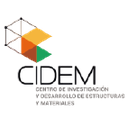Executive Secretary

IX Simposio Internacional de Química y Ciencias Farmaceúticas
SIQF 2025
XIV Conferencia “La ingeniería química: desarrollo, potencialidades y sus retos” y VI Simposio Internacional de “Seguridad tecnológica y ambiental”
Problemática: El desarrollo de una tecnología de cultivo intensivo de macroalgas requiere comprender las variables y parámetros que influyen en su crecimiento.
Objetivo: Modelar el comportamiento de las variables que afectan el crecimiento de Ulva lactuca.
Metodología: Se determinó la fórmula bioquímica y la ecuación del proceso fotosintético a partir de los compuestos orgánicos presentes. Se desarrollaron modelos matemáticos para describir el crecimiento, validándolos mediante una prueba estadística no paramétrica Mann-Whitney U. La evaluación experimental se realizó en un reactor rectangular con agitación (RCCA), donde se determinaron parámetros cinéticos usando el modelo de Monod. La simulación se llevó a cabo con Simulink en Matlab.
Resultados y discusión: La fórmula bioquímica (C₁₀.62H₄₂0.39O192.79N0.017P0.0058) y las reacciones fotosintéticas permitieron calcular un índice de consumo de 1,54 kg CO₂ por kg de biomasa producida. Los valores máximos de crecimiento específico (μmáx) y constante de saturación (ks)
fueron 2,628 y 0,0179, respectivamente, facilitando la validación y simulación del modelo con un nivel de significancia del 5%. Aumentar la concentración de CO₂ en aireación (de 760 a 3000 ppm), la intensidad lumínica a 2.500 μE/m²·s y la profundidad del medio incrementó el rendimiento en biomasa.
Conclusiones: Los modelos propuestos, considerando iluminación, profundidad, concentraciones de CO₂ y nutrientes (N₂), proporcionan información clave para el desarrollo tecnológico en cultivos macroalgales.
• Problem: Developing intensive macroalgae cultivation technology requires an understanding of the variables and parameters that influence growth.
• Object: To model the behaviour of the variables that affect the growth of Ulva lactuca.
• Methodology: The biochemical formula and equation of the photosynthetic process were derived from the organic compounds present. Mathematical models were developed to describe growth and were validated using a non-parametric Mann–Whitney U statistical test. The experimental evaluation was carried out in a rectangular stirred reactor (RCCA), where Kinetic parameters were determined using the Monod model. Simulation was performed using Simulink in Matlab.
• Results and discussion: The biochemical formula (C₁₀.₆₂H₄₂O₁₉₂.₇₉N₀.₀₁₇P₀.₀₀₅₈) and photosynthetic reactions were used to calculate a consumption rate of 1.54 kg CO₂ per kg of biomass produced. The consumption rate was calculated to be 1.54 kg of CO₂ per kg of biomass produced. The maximum values of specific growth (μ(max)) and the saturation constant (Ks) were found to be 2.628 and 0.0179 respectively, which facilitated the validation and simulation of the model at a significance level of 5%. Increasing the CO₂ concentration during aeration (from 760 to 3,000 ppm) increased the light intensity to 2,500 μE/m² s and the depth of the medium, increased the yield in biomass.
• Conclusions: The proposed models which consider illumination, depth, CO₂ and nutrient concentrations (N₂), provide key information for the technological development of macroalgal culture.
Sobre el ponente

Dra. Liset Roche Delgado

Discussion


 Oro
Oro
 Oro
Oro
 Plata
Plata
 Plata
Plata